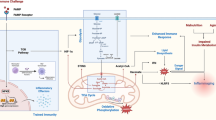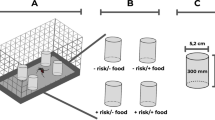Abstract
Dispersal has important ecological and evolutionary consequences but is a poorly understood behaviour. We experimentally tested whether activation of the immune system affects dispersal in male damselflies, Calopteryx virgo, from three natural populations. We show that males that contained an experimentally inserted artificial pathogen, a nylon monofilament implant, had higher dispersal rates and flew further than control males, but not further than sham manipulated males. Our data suggest that dispersal may reduce the risk of further infections if immune system activation indicates high parasite infection risk in the present habitat. We, thus, suggest that parasites may play an important role in the evolution of host dispersal.


Similar content being viewed by others
References
Åbro A (1996) Gregarine infection of adult Calopteryx virgo L. (Odonata: Zygoptera). J Nat Hist 30:855–859
Ahlroth P, Alatalo RV, Suhonen J (2009) Reduced dispersal propensity in the wingless waterstrider Aquarius najas in a highly fragmented landscape. Oecologia. doi:10.1007/s00442-009-1457-z
Andres JA, Cordero A (1998) Effects of water mites on the damselfly Ceriagrion tenellum. Ecol Entomol 23:103–109
Askew RR (1988) The dragonflies of Europe. Harley, London
Boulinier T, McCoy K, Sorci G (2001) Dispersal and parasitism. In: Clobert J, Danchin E, Dhondt AA, Nichols JD (eds) Dispersal. Oxford University Press, Oxford, pp 169–179
Bowler DE, Benton TG (2005) Causes and consequences of animal dispersal strategies: relating individual behaviour to spatial dynamics. Biol Rev 80:205–225
Brown CR, Brown MB (1992) Ectoparasitism as a cause of natal dispersal in cliff swallows. Ecology 73:1718–1723
Clobert J, Danchin E, Dhondt AA, Nichols JD (2001) Dispersal. Oxford University Press, Oxford
Comins HN, Hamilton WD, May RM (1980) Evolutionarily stable dispersal strategies. J Theor Biol 82:205–230
Conrad KF, Willson KH, Whitfield K, Harvey IF, Thomas CJ, Sherratt TN (2002) Characteristics of dispersing Ischnura elegans and Coenagrion puella (Odonata): age, sex, size, morph and ectoparasitism. Ecography 25:439–445
Contreras-Garduno J, Cordoba-Aguilar A, Lanz-Mendoza H, Cordero-Rivera A (2009) Territorial behaviour and immunity are mediated by juvenile hormone: the physiological basis of honest signalling? Funct Ecol 23:157–163. doi:10.1111/j.1365-2435.2008.01485.x
Corbet PS (1999) Dragonflies: behaviour and ecology of Odonata. Harley, Essex
Córdoba-Aguilar A, Cordero-Rivera A (2005) Evolution and ecology of calopterygidae (Zygoptera: Odonata): status of knowledge and research perspectives. Neotrop Entomol 34:861–879
Dixon AFG, Agarwala BK (1999) Ladybird-induced life-history changes in aphids. Proc R Soc Lond B 266:1549–1553
Forbes MR, Robb T (2008) Testing hypotheses about parasite-mediated selection using odonate hosts. In: Córdoba-Aguilar A (ed) Dragonflies and damselflies. Model organism for ecological and evolutionary research. Oxford University Press, Oxford, pp 175–188
Forbes MR, Muma KE, Smith BP (2004) Recapture of male and female dragonflies in relation to parasitism by mites, time of season, wing length and wing cell symmetry. Exp Appl Acarol 34:79–93
Hamilton WD, May RM (1977) Dispersal in stable habitats. Nature 269:578–581
Hastings A (1983) Can spatial variation alone lead to selection for dispersal. Theor Popul Biol 24:244–251
Heeb P, Werner I, Mateman AC, Kolliker M, Brinkhof MWG, Lessells CM, Richner H (1999) Ectoparasite infestation and sex-biased local recruitment of hosts. Nature 400:63–65
Holyoak M, Casagrandi R, Nathan R, Revilla E, Spiegel O (2008) Trends and missing parts in the study of movement ecology. Proc Natl Acad Sci USA 105:19060–19065. doi:10.1073/pnas.0800483105
Jaenike J, Benway H, Stevens G (1995) Parasite-induced mortality in mycophagous drosophila. Ecology 76:383–391
Koskimäki J, Rantala MJ, Taskinen J, Tynkkynen K, Suhonen J (2004) Immunocompetence and resource holding potential in the damselfly, Calopteryx virgo L. Behav Ecol 15:169–173
Koskimäki J, Rantala MJ, Suhonen J (2009) Wandering males are smaller than territorial males in the damselfly Calopteryx virgo (L.) (Zygoptera: Calopterygidae). Odonatologica 38:159–165
Lee KP, Cory JS, Wilson K, Raubenheimer D, Simpson SJ (2006) Flexible diet choice offsets protein costs of pathogen resistance in a caterpillar. Proc R Soc Lond B 273:823–829. doi:10.1098/rspb.2005.3385
Levin SA, Cohen D, Hastings A (1984) Dispersal strategies in patchy environments. Theor Popul Biol 26:165–191
Marden JH, Cobb JR (2004) Territorial and mating success of dragonflies that vary in muscle power output and presence of gregarine gut parasites. Anim Behav 68:857–865
Møller AP, Martin-Vivaldi M, Soler JJ (2004) Parasitism, host immune defence and dispersal. J Evol Biol 17:603–612
Moret Y, Schmid-Hempel P (2000) Survival for immunity: The price of immune system activation for bumblebee workers. Science 290:1166–1168. doi:10.1126/science.290.5494.1166
Pajunen VI (1966) Aggressive behaviour and territoriality in a population of Calotperyx virgo L. (Odonata: Calopterygidae). Ann Zool Fenn 3:201–214
Plaistow S, Siva-Jothy MT (1996) Energetic constraints and male mate-securing tactics in the damselfly Calopteryx splendens xanthostoma (Charpentier). Proc R Soc Lond B 263:1233–1238
Rantala MJ, Roff DA (2007) Inbreeding and extreme outbreeding cause sex differences in immune defence and life history traits in Epirrita autumnata. Heredity 98:329–336
Rantala MJ, Koskimäki J, Taskinen J, Tynkkynen K, Suhonen J (2000) Immunocompetence, developmental stability and wingspot size in the damselfly Calopteryx splendens L. Proc R Soc Lond B 267:2453–2457
Rantala MJ, Hovi M, Korkeamäki E, Suhonen J (2001) No trade-off between the size and timing of emergence in the damselfly, Calopteryx virgo L. Ann Zool Fenn 38:117–122
Ronce O (2007) How does it feel to be like a rolling stone? Ten questions about dispersal evolution. Annu Rev Ecol Evol Syst 38:231–253. doi:10.1146/annurev.ecolsys.38.091206.095611
Shields WM (1987) Optimal inbreeding and evolution of philopatry. In: The ecology of animal movement. Clarendon, pp 132–159
Siva-Jothy MT (2000) A mechanistic link between parasite resistance and expression of a sexually selected trait in a damselfly. Proc R Soc Lond B 267:2523–2527. doi:10.1098/rspb.2000.1315
Sloggett JJ, Weisser WW (2002) Parasitoids induce production of the dispersal morph of the pea aphid, Acyrthosiphon pisum. Oikos 98:323–333
Snoeijs T, Van de Casteele T, Adriaensen F, Matthysen E, Eens M (2004) A strong association between immune responsiveness and natal dispersal in a songbird. Proc R Soc Lond B 271:S199–S201
Sorci G, Massot M, Clobert J (1994) Maternal parasite load increases sprint speed and philopatry in female offspring of the common lizard. Am Nat 144:153–164
Stettmer C (1996) Colonisation and dispersal patterns of banded (Calopteryx splendens) and beautiful demoiselles (C. virgo) (Odonata: Calopterygidae) in south-east German streams. Eur J Entomol 93:579–593
Suhonen J, Rantala MJ, Honkavaara J (2008) Territoriality in odonates. In: Córdoba-Aguilar A (ed) Dragonflies and damselflies: model organisms for ecological and evolutionary research. Oxford University Press, Oxford, pp 203–217
Svensson EI, Eroukhmanoff F, Friberg M (2006) Effects of natural and sexual selection on adaptive population divergence and premating isolation in a damselfly. Evolution 60:1242–1253
Taylor PD, Merriam G (1995) Wing morphology of a forest damselfly is related to landscape structure. Oikos 73:43–48
Taylor PD, Merriam G (1996) Habitat fragmentation and parasitism of a forest damselfly. Landsc Ecol 11:181–189
Tynkkynen K, Kotiaho JS, Luojumäki M, Suhonen J (2006) Interspecific territoriality in Calopteryx damselflies: the role of secondary sexual characters. Anim Behav 71:299–306
Van Vuren D (1996) Ectoparasites, fitness and social behaviour of yellow-bellied marmots. Ethology 102:686–694
Weisser WW, Braendle C, Minoretti N (1999) Predator-induced morphological shift in the pea aphid. Proc R Soc Lond B 266:1175–1181
Acknowledgments
We thank Henna Aaltonen, Jaakko Ilvonen, Katariina Kangassalo, Kari Kaunisto, Janne Kumpulainen, Topias Laaksonen, Kalle Laitila, Pipsa Lappalainen, Urzula Malinkowska, Lauri Rantanen, Eeva Rönnholm, Teijo Saikkonen, Anna Sipilä, Anssi Susilahti, Sini Tuomola and Heidi Viitaniemi for assistance in the field. Special thanks to Alexandro Cordoba-Aguilar, Andre Dhondt and Derek Dunn for comments on the manuscript. In addition, D. Dunn kindly checked the English. This study was supported by the Academy of Finland to M. J. R., J. H. and J. S.
Author information
Authors and Affiliations
Corresponding author
Additional information
Communicated by Carla Caceres.
Rights and permissions
About this article
Cite this article
Suhonen, J., Honkavaara, J. & Rantala, M.J. Activation of the immune system promotes insect dispersal in the wild. Oecologia 162, 541–547 (2010). https://doi.org/10.1007/s00442-009-1470-2
Received:
Accepted:
Published:
Issue Date:
DOI: https://doi.org/10.1007/s00442-009-1470-2




